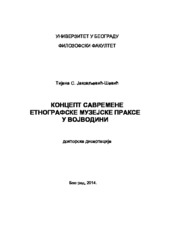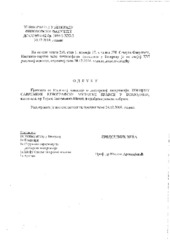Приказ основних података о дисертацији
Концепт савремене етнографске музејске праксе у Војводини
The concept of contemporary ethnographic museum practice in Vojvodina
| dc.contributor.advisor | Ćupurdija, Branko | |
| dc.contributor.other | Nedeljković, Saša B. | |
| dc.contributor.other | Radović, Srđan | |
| dc.contributor.other | Gavrilović, Ljiljana | |
| dc.creator | Jakovljević-Šević, Tijana S. | |
| dc.date.accessioned | 2020-07-03T10:01:19Z | |
| dc.date.available | 2020-07-03T10:01:19Z | |
| dc.date.issued | 2015-02-12 | |
| dc.identifier.uri | https://nardus.mpn.gov.rs/handle/123456789/4654 | |
| dc.identifier.uri | http://eteze.bg.ac.rs/application/showtheses?thesesId=2458 | |
| dc.identifier.uri | https://fedorabg.bg.ac.rs/fedora/get/o:10472/bdef:Content/download | |
| dc.identifier.uri | http://vbs.rs/scripts/cobiss?command=DISPLAY&base=70036&RID=526170007 | |
| dc.description.abstract | У време оснивања првих музеја у Европи етнологија/антропологија је развијала своја интересовања у правцу истраживања „других“ и „далеких“ култура, као и ка истраживању „националне“ или „етничке“ културе. Ова два правца истраживања одразила су се двојако на конципирање музејских збирки. Са једне стране почеле су да се формирају збирке „егзотичних“ и „ретких“ предмета, а са друге, предмета који су репрезентовали карактеристике локалне културе, традиције и идентитета. У складу са овим другим критеријумом формиране су и етнографске збирке у домаћим музејима. Оне су у свом раду као циљ поставиле приказивање традицијскe културe локалних заједница. Као главне карактеристике предмета који су увођени у етнографске збирке постављени су старост, естетика и повезаност са културом руралне средине. Овакви критеријуми за избор предмета у нашим музејима представљали су одраз дешавања у теоријској етнологији која је била усмерена на проучавање свих аспеката традицијске, „патријархалне“ културе. Током седамдесетих година интересовања теоријске етнологије/антропологије почињу да се померају са „традиционалног сеоског друштва и културе“ на урбану средину и савременост. У том периоду је и светска музеологија већ била захваћена променама које су се рефлектовале као померања фокуса са музејског предмета на људе. Међутим, наведене промене се нису знатније одразиле на етнографску музеологију у нашим музејима. На почетку 21. века домаћа етнографска музеологија се сусрела са бројним критикама, посебно из угла теоријске етнологије/антропологије. Оне су се односиле на сва поља деловања, на проблеме и артефакте које третира, концепције изложби и интерпретацију наслеђа. Суочавајући се са критикама и покушавајући да одговоре на изазове савремености, музејски етнолози/антрополози су започели организован рад на редефинисању етнографске музеологије. Данас сакупљање, чување и излагање етнографских предмета није више ограничено само на званичне музеје. Као последица друштвених околности и процеса ретрадиционализације у последњим деценијама 20. века настао је један паралелан облик музејске праксе који третира елементе традицијске културе. Он се развија кроз различите облике приватних етнографских музеја и свој концепт заснива на пракси званичних музејских институција. Овај рад је усредсређен на представљање етнографске музеологије у комплексним музејима у Војводини, њене употребе у „опросторавању“ (spatialization) локалног и регионалног идентитета, као и анализе одраза започетих модернизацијских процеса на праксу ових музеја. У оквиру концепта приватних збирки и музеја, опонашања званичне праксе у третирању традицијске културе и презентације локалних идентитета, биће сагледан и њихов рад као одређени облик алтернативне етнографске музејске праксе. Кључне речи: етнографски предмет, етнографска музеологија, редефинисање, музеји у Војводини, приватни музеји, „опросторавање“, идентитет. | sr |
| dc.description.abstract | At the time of the establishment of the first museums in Europe, ethnology and anthropology developed its interests in exploring “other” and “distant” cultures, simultaneously researching “national” or “ethnic” culture. These two exploration routes reflected differently on the concept of museum collections. On one hand, the establishment of collections of “exotic” and “rare” objects took place, and on the other hand, the collections of objects which capture the features of local culture, tradition, and identity. In accordance with the latter criterion, domestic museums founded new ethnographic collections who were aiming to display the traditionalist cultures of local communities. The main features, such as age, esthetics, and the connection with the culture of the rural surrounding, were set for objects which were acquired by the ethnographic collections. These criteria for choosing objects in domestic museums epitomize the circumstances in theoretical ethnology which was orientated towards exploring all aspects of a traditionalist, “patriarchal” culture. During the 70s, the focus of theoretical ethnology and anthropology started moving from the “traditional, rural society and culture” to civic surrounding and modernity. It was the time when the worldwide museology was already affected by the changes reflected as the transfers of focus from a museum object to population. However, these changes have not significantly impacted the ethnographic museology in domestic museums. At the beginning of the 21st century, the domestic ethnographic museology faced numerous criticism, especially from the point of theoretical ethnology and anthropology. The criticism referred to all fields of study, to problems and artefacts it treated, to concepts of exhibitions, and to the interpretation of heritage. Confronting the criticism and trying to respond to the challenges of modernity, museum ethnologists and anthropologists began an organized work on redefining the ethnographic museology. Today, collecting, keeping and exhibiting ethnographic objects is no longer limited only to official museums. As a consequence of social circumstances and the process of retraditionalisation in the last decades of the 20th century, a parallel form of museum practice appeared that treated the elements of a traditionalist culture. It has been developing through different forms of private ethnographic museums and has been establishing its concept on the practice of official museum institutions. This work concentrates on presentations of ethnographic museology in complex museums of Vojvodina, its use in spatialization of local and regional identity, and the analysis into the influence of the initiated modernization processes on the museum practice. With respect to the concept of the private collections and museums, and the imitation of the formal practice in treating traditionalist culture and presenting local identities, their work will also be observed as a specific form of alternative, ethnographic, museum practice. | en |
| dc.format | application/pdf | |
| dc.language | sr | |
| dc.publisher | Универзитет у Београду, Филозофски факултет | sr |
| dc.rights | openAccess | en |
| dc.rights.uri | https://creativecommons.org/licenses/by-nc-nd/4.0/ | |
| dc.source | Универзитет у Београду | sr |
| dc.subject | етнографски предмет | sr |
| dc.subject | ethnographic object | en |
| dc.subject | етнографска музеологија | sr |
| dc.subject | редефинисање | sr |
| dc.subject | музеји у Војводини | sr |
| dc.subject | приватни музеји | sr |
| dc.subject | „опросторавање“ | sr |
| dc.subject | идентитет | sr |
| dc.subject | ethnographic museology | en |
| dc.subject | redefining | en |
| dc.subject | museums in Vojvodina | en |
| dc.subject | private museums | en |
| dc.subject | spatialization | en |
| dc.subject | identity | en |
| dc.title | Концепт савремене етнографске музејске праксе у Војводини | sr |
| dc.title | The concept of contemporary ethnographic museum practice in Vojvodina | en |
| dc.type | doctoralThesis | en |
| dc.rights.license | BY-NC-ND | |
| dcterms.abstract | Ћупурдија, Бранко; Недељковић, Саша Б.; Радовић, Срђан; Гавриловић, Љиљана; Јаковљевић-Шевић, Тијана С.; Koncept savremene etnografske muzejske prakse u Vojvodini; | |
| dc.identifier.fulltext | https://nardus.mpn.gov.rs/bitstream/id/26958/Disertacija396.pdf | |
| dc.identifier.fulltext | https://nardus.mpn.gov.rs/bitstream/id/26959/Tijana_Jakovljevic_Sevic.pdf | |
| dc.identifier.fulltext | http://nardus.mpn.gov.rs/bitstream/id/26958/Disertacija396.pdf | |
| dc.identifier.fulltext | http://nardus.mpn.gov.rs/bitstream/id/26959/Tijana_Jakovljevic_Sevic.pdf | |
| dc.identifier.rcub | https://hdl.handle.net/21.15107/rcub_nardus_4654 |



